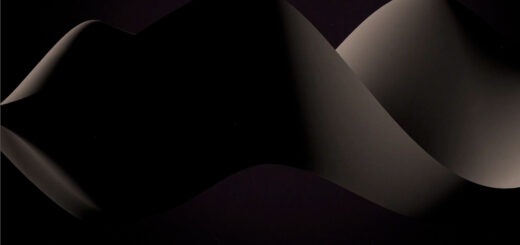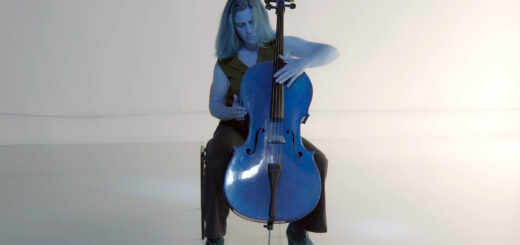June Young Will Kim: Black, Emerald
Beschreibung / Description:
“Black, Emerald” is the 3rd piece in my series of works for an amplified canvas, continuing my search for a synergistic relationship between the visual and musical domains of art, where the two domains influence each other at an equal level rather than one being the byproduct or mere trace of the other. For example, because the sound of the brush making contact with the canvas is amplified and processed with MaxMSP, a variation of the visual motif directly results in a variation of the rhythmic motif, and vice versa. In this particular piece, I’m exploring how visual structure and deviance can be reflected musically. (And of course, vice versa) The piece opens with the principle visual/rhythmic motif of the piece, a gesture consisting of a black curved line connected to another in the opposite direction. This motif undergoes various repetitions and variations, such as extending one of the curved lines so that it loops around or adding more changes in direction without lifting the brush to create a shape consisting of three or four connected curved lines. Reiterations and variations of the principle motif are arranged in space to form five black compound shapes. After each compound shape follows a secondary motif in emerald, which is always painted straight. This dichotomy between the curved and straight lines corresponds to the dichotomy between the two colors: emerald and black, and it also extends into the larger form: between each of the serrated compound shapes and the lone emerald straight line, similar to the dichotomy of forms perceivable in many works of artists such as Adolph Gottlieb or Agnes Martin. In the musical domain, the canvas sounds from the black gestures are processed through filters and a tremolo effect with the motion sensor’s velocity values controlling the tremolo speed, whereas the canvas sounds from the emerald gestures do not undergo a dynamic motion process effect but rather a static filter with slight granulation. The black gestures are made with constant changes in brushing speed, whereas the emerald gestures are instructed to be painted at a steady speed.
Besides black and emerald, it could be said that there is a third color in the piece: the white of the canvas. Surely, the periods between each of the painting gestures are not silent: the musical events for these in-between moments in between have a specific unifying characteristic. I constrained these in-between moments to quieter and sparser textures in order to establish an aural figure-ground relationship, just like its visual counterpart. The colors black and emerald were chosen because I wanted to explore Hans Hofmann’s Push/Pull theory in this piece. Push/Pull theory describes how certain juxtapositions of shapes or colors can create depth and motion in still paintings. Warmer colors stand out amongst colder colors and draw a certain attention to them. To reflect this in the musical domain, a soft, bright and steady timbre is assigned to the instrumental ensemble whenever the emerald color motif is painted on.
Another concept explored in this piece is Salvatore Sciarrino’s concept of “Little Bang,” which describes that the human perception continually imposes cause and effect relationships between phenomena, that in two consecutive events, the first will be perceived as the generating event (Big Bang) and the second will be perceived as the product (Little Bang). According to this concept, the musical sections corresponding to each of the black compound shapes are perceived as Big Bangs and the emerald musical gestures that follow as Little Bangs. This Big Bang – Little Bang sequence is repeated three times before the balance is overthrown. The fourth compound shape is not a true compound shape, since it consists only of one continuous gesture. Then follows four iterations of the emerald gesture in succession, creating a shift in the Big Bang-Little-Bang relationship that was established. Gradually, as the emerald gesture is repeated not just once but three more times over a substantial amount of time-space, the emerald begins to take the role of the Big Bang both visually and musically for this section. I then reinforce this newly established balance by painting the last emerald gesture before the black compound shape rather than painting the emerald gesture after the black compound shape like in the previous iterations.
Biografie / Biography:
Composer and baritone June Young (Will) Kim was born in 1996 in South Korea and has lived in Canada, United States and Germany. Originally a classically trained Clarinetist and Jazz pianist, he began writing his first notes as a singer-songwriter before turning to concert music composition, and bases many of his compositions on his own unapologetic texts. Since 2020, he has been particularly interested in exploring relationships between the visual and musical arts to create pieces where the two have a synergistic relationship rather than one being a byproduct or a mere trace of the other. Works exploring such concepts include multiple pieces for an amplified canvas, Max MSP and instruments. He is also interested in incorporating entomological elements into his music. His teachers in composition include Isabel Mundry, Chaya Czernowin, Michael Beil, Salvatore Sciarrino, Marco Stroppa, Unsuk Chin, George Benjamin, Klaus Lang, Brian Ferneyhough, Valerio Sannicandro, Frédéric Durieux and Sven-David Sandström.
His music has been performed by ensembles such as Quartetto Prometeo, members of the Berlin Philharmonic, members of the International Ensemble Modern Academy, Syntax Ensemble and Ensemble Paramirabo.
He received his Bachelor in Composition from the Jacobs School of Music, Indiana University Bloomington in 2018 and his Masters in Composition at Hochschule Für Musik und Theater München funded by the DAAD scholarship, studying with Isabel Mundry. He is now pursuing the II Level Master in Composition program at the Conservatorio di Milano “Giuseppe Verdi” from March – Oct 2021 studying with Marco Stroppa, George Benjamin, Unsuk Chin, Klaus Lang and Alberto Posadas.
Interpreten und Ort / Interprets and Location:
- Sakhile Humbane – Flöte
- Adrian Sands – Violoncello
- Robert Florian Daniel – Klavier
- June Young Will Kim – Leinwand/Elektronik



























